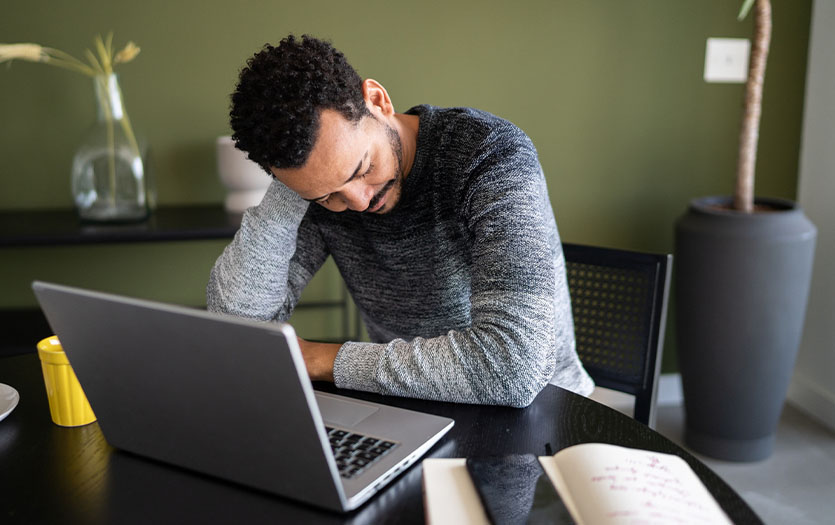
This post was written by Jithmie Jayawickrema, PT, DPT, OCS, and Sean Collins, PT, DPT, COMT, CEAS I, Therapy Services – Southwest, Parkview Health.
More and more, we’re hearing about pain and complications resulting from “tech neck.” Defined as an overuse syndrome precipitated by prolonged and repetitive cervical flexion (looking down), the condition is linked to our increased reliance on handheld devices. In this post, we’ll explore the risks of tech neck, key points of prevention and how to address pain associated with the condition on your own or with the assistance of physical therapy.
Defining tech neck
Tech neck is most commonly associated with straining of the neck and back musculature due to prolonged and repetitive use of technology such as smartphones, tablets and computers. This often results in discomfort because the weight of your head increases when it is flexed forward, which increases strain on muscles, ligaments, tendons and bony structures. From a clinical perspective, tech neck is akin to poor posture and cervical strain.
Symptoms
Those suffering from tech neck, often report:
- Neck/upper back pain
- Neck tightness
- Head feels heavy
- Dizziness
- Headaches
Risks
Whenever someone develops a musculoskeletal impairment, they are at risk of some complications, including but not limited to:
- Weakness of the cervical and periscapular musculature
- Muscle spasms and tightness of musculature
- Reduced range of motion in the cervical and thoracic spine
- Increased intensity and frequency of headaches
- Jaw pain
- Mid and lower back pain
- Psychological effects of reduced social interaction
- Decreased physical activity leading to a higher risk of comorbidities affecting quality of life
- Eye strain
Preventing and treating tech neck
As physical therapists, there are many ways we can prevent, treat, manage and help prevent tech neck.
Prevention is the best medicine, so we typically start with education on strategies that can reduce the risk of tech neck. From there, we can explore techniques and treatments to alleviate some of the symptoms. Here are some of the key areas of concentrations for tech neck:
Posture
General education around the proper way to hold and support your body is key to reducing the effects of tech neck, so postural guidance is a cornerstone of therapy. Staying aligned, with your chin up, shoulders back and body upright is a great place to start.
Take breaks
Your best posture is your next posture, meaning no matter what position you’re in, you need to be mindful of moving. Set an alarm so that you remember to put down whatever device you’re holding and walk, sway or stretch at regular intervals.
Stretch
Stretching should be part of your daily routine and schedule. You can find neck, shoulder and back stretches online or by consulting your physical therapist.
Reduce screen time
It’s important for you to develop an individualized strategy for reducing your daily screen time, including your laptop, phone and tablets. Many devices have record of your weekly screen time, which can give you an idea of your baseline. From there, work to reduce unnecessary scrolling and staring. If necessary, set an alarm as a reminder to put the device down.
Watch: Mindfulness and technology
Follow the 20-20-20 rule
Every 20 minutes, look 20 feet away from all screens for 20 seconds. An alarm can come in handy for this one. This is great for your mind, eyes and, yes, your neck.
Assess your workstation
Make sure that the area where you are spending the most time on screens, whether that be your desk for school or work, or a table with your laptop, is set up to minimize strain on your body.
Check out: Setting up your home work station
How to avoid neck pain at your desk
Setting up your desk for success
Focus on strength
Your physical therapist can help you develop an exercise program that focuses on building strength and/or endurance in the involved musculature. This could include the core, shoulders and other areas that support and stabilize your body while seated and necessary to maintain proper posture.
Taping
A physical therapist can teach you a taping technique to promote postural awareness.
Hands-on approach
Of course, a physical therapist can apply manual therapy to address soft tissue and joint restrictions and help alleviate pain. This would likely be used in tandem with some of the techniques and education mentioned above.
For more information, or to schedule with one of our expert physical therapists at any of our locations, call 260-266-7400.
References



